This document provides an overview of functional programming concepts in ES6 including:
1. Array methods like filter, map, reduce, and destructuring for manipulating arrays in a functional style with no side effects.
2. Methods for comparing, merging, and transforming arrays like finding differences, intersections, and unions.
3. Working with nested/deep arrays through functions like deepFindItem to search nested objects.
4. Functional rules like purity, immutability, and composition are discussed in contrast with imperative programming.
5. Examples of chaining array operations through function composition are provided.
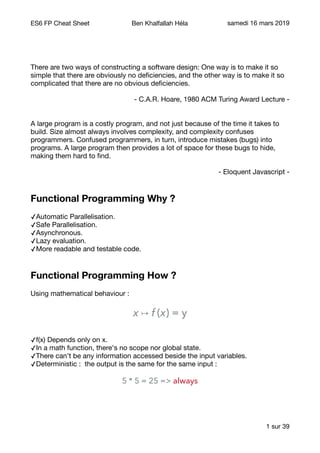
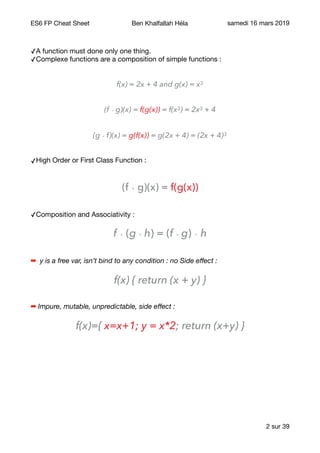
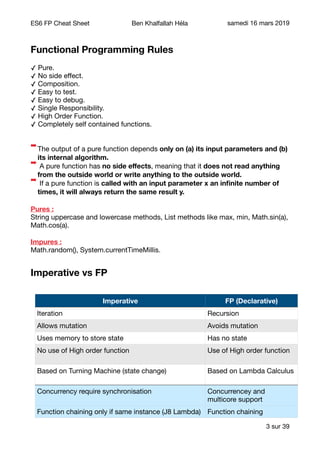
![ES6 FP Cheat Sheet Ben Khalfallah Héla samedi 16 mars 2019
ES6
Array :
Primitive arrays :
// primitive array type
const tab1 = [1, 2, 3, 12, 4, 5, ‘A']
const tab2 = [1, 2, 78, 3, 189]
// find item
const findItem = (tab, query) =>
tab.filter(item => item === query)
// compare two array and return differences
// symmetric difference
// return elements from tab1 that don't exist
// on tab2 and elements from tab2
// that don't exist on tab1
const arrayDifference = (tab1, tab2) => [
...tab1.filter(item => findItem(tab2, item).length === 0),
...tab2.filter(item => findItem(tab1, item).length === 0),
]
➡ console.log('Differences : ', arrayDifference(tab1, tab2))
// [ 12, 4, 5, 'A', 78, 189 ]
// array intersections
// find common elements
const arrayIntersection = (tab1, tab2) =>
tab1.filter(item => findItem(tab2, item).length > 0)
➡ console.log('Intersection : ', arrayIntersection(tab1, tab2))
// [ 1, 2, 3 ]
sur4 39](https://image.slidesharecdn.com/fp-es6-cheat-sheet-190316121839/85/FP-Using-ES6-Cheat-Sheet-4-320.jpg)
![ES6 FP Cheat Sheet Ben Khalfallah Héla samedi 16 mars 2019
// Union : merge arrays
// and eliminate duplication
const arrayUnion = (tab1, tab2) => [
...new Set([...tab1, ...tab2]),
]
➡ console.log('Union : ', arrayUnion(tab1, tab2))
// [ 1, 2, 3, 12, 4, 5, 'A', 78, 189 ]
// intersection + difference
// intersection is like a Set()
// to eliminate duplicated elements
const arrayUnion2 = (tab1, tab2) => [
...arrayIntersection(tab1, tab2),
...arrayDifference(tab1, tab2),
]
➡ console.log('Union 2 : ', arrayUnion2(tab1, tab2))
// [ 1, 2, 3, 12, 4, 5, 'A', 78, 189 ]
// keep only string
const keepOnlyString = tab =>
tab.filter(item => (typeof item === 'string'))
➡ console.log('Keep only string : ', keepOnlyString(tab1))
// [ 'A']
sur5 39](https://image.slidesharecdn.com/fp-es6-cheat-sheet-190316121839/85/FP-Using-ES6-Cheat-Sheet-5-320.jpg)
![ES6 FP Cheat Sheet Ben Khalfallah Héla samedi 16 mars 2019
// count number of elements that are not string
const totalNotString = tab =>
tab.reduce((total, amount) =>
((typeof amount !== 'string') ? total + 1 : total), 0)
➡ console.log('Count number of elements that are not string (tab1):
', totalNotString(tab1)) // 6
➡ console.log('Count number of elements that are not string (tab2):
', totalNotString(tab2)) // 5
// compose function
const compose = x => y => f => g => g(f(x, y))
// compose : chaining operations
const composeUnionTotalNotString = compose(tab1)(tab2)(arrayUnion)
(totalNotString)
➡ console.log('union total not string 2: ‘,
composeUnionTotalNotString) // 8
// modify array values
const modifyArrayValues = array => (array.map(item => item + 2))
const tab3 = [1, 2, -2, -1, -4, 3, 4, 5, 6, 7, 0]
const modifiedArray = modifyArrayValues(tab3)
➡ console.log('Modified Array : ', modifiedArray)
// [ 3, 4, 0, 1, -2, 5, 6, 7, 8, 9, 2 ]
sur6 39](https://image.slidesharecdn.com/fp-es6-cheat-sheet-190316121839/85/FP-Using-ES6-Cheat-Sheet-6-320.jpg)
![ES6 FP Cheat Sheet Ben Khalfallah Héla samedi 16 mars 2019
// check if all items in array
// satisfy a specific condition
const isAllItemsPositives = array =>
(array.every(item => item > 0))
// check if all array item satisfy
// a specific condition
const tab4 = [1, 2, -2, -1, -4, 3, 4, 5, 6, 7, 0]
➡ console.log('is All Items Positives : ',
isAllItemsPositives(tab4))
//false
const arrayPositive = [4, 8, 9, 12, 7]
➡ console.log('is All Items Positives : ',
isAllItemsPositives(arrayPositive))
// true
// combine/concat arrays
const tab1 = [1, 2, 3, 4, 5]
const tab2 = [7, 8, 9, 10, 11]
const tab3 = [...tab1, ...tab2]
➡ // [ 1, 2, 3, 4, 5, 7, 8, 9, 10, 11 ] : like arr3.concat(arr1, arr2)
// add at the end
const tab4 = ['a', 'b', 'c']
tab3.push(...tab4)
➡ // [ 1, 2, 3, 4, 5, 7, 8, 9, 10, 11, 'a', 'b', 'c' ] : like
arr3.push.apply(arr3, arr4)
// add at the begin
const tab5 = ['A', 'B', 'C']
tab3.unshift(...tab5)
➡ // [ 'A','B','C',1,2, 3, 4, 5, 7, 8, 9, 10, 11, 'a', 'b', 'c' ]
sur7 39](https://image.slidesharecdn.com/fp-es6-cheat-sheet-190316121839/85/FP-Using-ES6-Cheat-Sheet-7-320.jpg)
![ES6 FP Cheat Sheet Ben Khalfallah Héla samedi 16 mars 2019
// get the max & min of an array
const numbers = [1, 25, 3, 4, 5]
const max = Math.max(numbers)
➡ // undefined
const min = Math.min(numbers)
➡ // undefined
const maxNumber = Math.max(...numbers)
➡ // 25 : like Math.max.apply(Math, [1, 25, 3, 4, 5])
const minNumer = Math.min(...numbers)
➡ // 1
// If you destruct an Array,
// you can choose to only extract a prefix
const [elm1, elm2] = ['a', 'b', 'c', 'f', 's']
➡ console.log('elm1 : ', elm1) // a
➡ console.log('elm2 : ', elm2) // b
// or skip
const [, , elm3, elm4] = ['a', 'b', 'c', 'd', 'f', 's']
➡ console.log('elm3 : ', elm3) // c
➡ console.log('elm4 : ', elm4) // d
// or skip & rest
const [, , ...rest] = ['a', 'b', 'c', 'd', 'f', 's']
➡ console.log('rest : ', rest) // [ 'c', 'd', 'f', 's']
// If the operator can’t find any elements,
// it matches its operand against the empty Array.
// That is, it never produces undefined or null
const [val1, val2, ...val3] = ['a']
➡ console.log('val1 : ', val1) // a
➡ console.log('val2 : ', val2) // undefined
➡ console.log('val3 : ', val3) // []
sur8 39](https://image.slidesharecdn.com/fp-es6-cheat-sheet-190316121839/85/FP-Using-ES6-Cheat-Sheet-8-320.jpg)
![ES6 FP Cheat Sheet Ben Khalfallah Héla samedi 16 mars 2019
Deep arrays :
// deep arrays
const tabObject1 = [{
name: 'Héla',
lastName: 'Ben Khalfallah',
},
{
name: 'Steve',
lastName: 'Jobs',
},
{
name: 'Pablo',
lastName: 'Picasso',
}]
const tabObject2 = [{
name: 'Héla',
lastName: 'Ben Khalfallah',
note: 14,
},
{
name: 'Dan',
lastName: 'Abramov',
note: 17,
},
{
name: 'Steve',
lastName: 'Jobs',
note: 16,
},
{
name: 'Albert',
lastName: 'Einsten',
note: 18,
}]
sur9 39](https://image.slidesharecdn.com/fp-es6-cheat-sheet-190316121839/85/FP-Using-ES6-Cheat-Sheet-9-320.jpg)
![ES6 FP Cheat Sheet Ben Khalfallah Héla samedi 16 mars 2019
// deep find item
const deepFindItem = (tab, query) =>
tab.filter(item => item.name === query.name)
// deep arrays difference
// 1. find tab1 difference
// 2. find tab2 difference
const deepArrayDifference = (tab1, tab2) => [
...tab1.filter(item => deepFindItem(tab2, item).length === 0),
...tab2.filter(item => deepFindItem(tab1, item).length === 0),
]
➡ console.log('Deep Difference : ', deepArrayDifference(tabObject1,
tabObject2))
// [ { name: 'Pablo', lastName: 'Picasso' },
// { name: 'Albert', lastName: 'Einsten' },
// { name: 'Dan', lastName: 'Abramov' } ]
// deep array intersections
// find common elements
const deepArrayIntersection = (tab1, tab2) =>
tab1.filter(item => deepFindItem(tab2, item).length > 0)
➡ console.log('Deep Intersection : ',
deepArrayIntersection(tabObject1, tabObject2))
// [ { name: 'Héla', lastName: 'Ben Khalfallah' },
// { name: 'Steve', lastName: 'Jobs' } ]
sur10 39](https://image.slidesharecdn.com/fp-es6-cheat-sheet-190316121839/85/FP-Using-ES6-Cheat-Sheet-10-320.jpg)
![ES6 FP Cheat Sheet Ben Khalfallah Héla samedi 16 mars 2019
// 1. find common elements tab1 & tab2
// 2. find tab1 difference
// 3. find tab2 difference
// 4. merge result
// intersection + difference
// intersection is like a Set()
// to eliminate duplicated elements
const deepArrayUnion = (tab1, tab2) => [
...deepArrayIntersection(tab1, tab2),
...deepArrayDifference(tab1, tab2),
]
➡ console.log('Deep Union : ', deepArrayUnion(tabObject1,
tabObject2))
// [ { name: 'Héla', lastName: 'Ben Khalfallah' },
// { name: 'Steve', lastName: 'Jobs' },
// { name: 'Pablo', lastName: 'Picasso' },
// { name: 'Albert', lastName: 'Einsten' },
// { name: 'Dan', lastName: 'Abramov' } ]
// chaining operations
const sortChain = tabObject2
.filter(item => item.name.toLowerCase().includes('e'))
.sort((item, next) => {
if (item.name < next.name) { return -1 }
if (item.name > next.name) { return 1 }
return 0
})
➡ console.log('Sort Chain : ', sortChain)
// [ { name: 'Albert', lastName: 'Einsten', note: 18 },
// { name: 'Steve', lastName: 'Jobs', note: 16 } ]
sur11 39](https://image.slidesharecdn.com/fp-es6-cheat-sheet-190316121839/85/FP-Using-ES6-Cheat-Sheet-11-320.jpg)
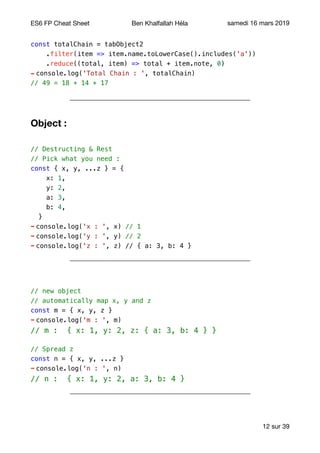
![ES6 FP Cheat Sheet Ben Khalfallah Héla samedi 16 mars 2019
// Nested Destructing
// define your pattern
const options = {
size: {
width: 100,
height: 200,
},
items: ['Cake', 'Donut'],
extra: true,
}
// nested destructing
const {
size: { // put size here
width,
height,
},
items: [item1, item2], // assign items here
title = 'Menu', // not present in the object (default value is used)
} = options
➡ console.log('title : ', title) // Menu
➡ console.log('width : ', width) // 100
➡ console.log('height : ', height)// 200
➡ console.log('item1 : ', item1) // Cake
➡ console.log('item2 : ', item2) // Donut
sur13 39](https://image.slidesharecdn.com/fp-es6-cheat-sheet-190316121839/85/FP-Using-ES6-Cheat-Sheet-13-320.jpg)
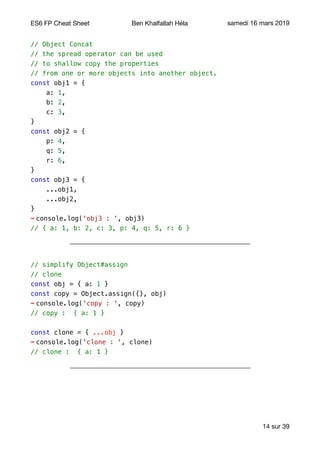
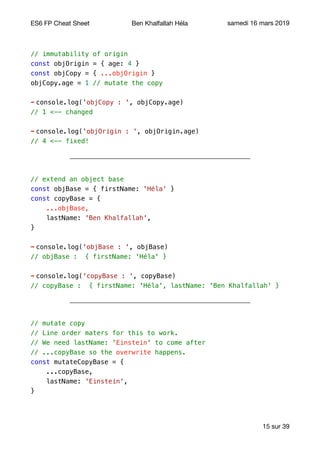
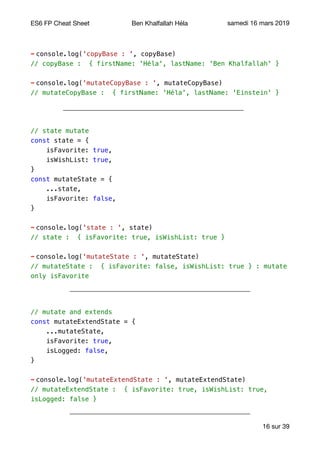
![ES6 FP Cheat Sheet Ben Khalfallah Héla samedi 16 mars 2019
String :
// Spread a string
// or convert string to char array
// or split
const strTemplate = 'Steve'
const chars = [...strTemplate] // like split('')
➡ console.log('chars : ', chars)
// chars : [ 'S', 't', 'e', 'v', 'e' ]
// reverse a string
const reverse = str => (
str
.split(' ')
.map(word => word.split('').reverse().join(''))
.reverse()
.join(' ')
)
➡ console.log('reverse :', reverse('Argument goes here'))
//reverse : ereh seog tnemugrA
// capitalise string words
const capitaliseWords = str => (
str
.split(' ')
.map(word =>
word.replace(word.charAt(0), word.charAt(0).toUpperCase()))
.join(' ')
)
➡ console.log('capitalise Words :', capitaliseWords('Argument goes
here'))
// capitalise Words : Argument Goes Here
sur17 39](https://image.slidesharecdn.com/fp-es6-cheat-sheet-190316121839/85/FP-Using-ES6-Cheat-Sheet-17-320.jpg)
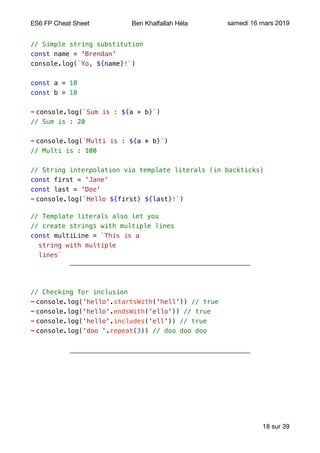



![ES6 FP Cheat Sheet Ben Khalfallah Héla samedi 16 mars 2019
High-Order Functions :
Functions that operate on other functions, either by taking them as arguments
or by returning them, are called higher-order functions.
- Eloquent Javascript -
const users = [
{ name: 'aaName', lastname: 'cclastName', note: 12 },
{ name: 'ccName', lastname: 'aalastName', note: 13 },
{ name: 'bbName', lastname: 'bblastName', note: 7 },
]
// sort by criteria
// partial arguments application
const sortBy = property => (a, b) => {
if (a[property] < b[property]) {
return -1
}
if (a[property] > b[property]) {
return 1
}
return 0
}
const sortedByNameUsers = users.sort(sortBy('firstname'))
➡ console.log('sort by name: ', sortedByNameUsers)
// [ { firstname: 'aaFirstName', lastname: 'cclastName' },
// { firstname: 'bbFirstName', lastname: 'bblastName' },
// { firstname: 'ccFirstName', lastname: 'aalastName' } ]
const sortedByNoteUsers = users.sort(sortBy('note'))
➡ console.log('sort by note: ', sortedByNoteUsers)
// [ { name: 'bbName', lastname: 'bblastName', note: 7 },
// { name: 'aaName', lastname: 'cclastName', note: 12 },
// { name: 'ccName', lastname: 'aalastName', note: 13 } ]
sur22 39](https://image.slidesharecdn.com/fp-es6-cheat-sheet-190316121839/85/FP-Using-ES6-Cheat-Sheet-22-320.jpg)
![ES6 FP Cheat Sheet Ben Khalfallah Héla samedi 16 mars 2019
users.sort(sortBy('note'))
=> sort : function 1.
=> sortBy : function 2.
=> sort call sortBy that call compare.
Always composition over inheritance !
➡ reduces repetitive code
➡ easier reuse of code
➡ increases clarity of code meaning
// take function and arguments
// return function(arguments)
const transform = f => (...args) => f(...args)
const tranformMin = transform(Math.min)(3, 2, 1)
➡ console.log('tranform min: ', tranformMin)
// 1
const tranformSort = transform(Array.sort)(users, sortBy('name'))
➡ console.log('tranformSort: ', tranformSort)
// sort by name:
// [ { name: 'aaName', lastname: 'cclastName', note: 12 },
// { name: 'bbName', lastname: 'bblastName', note: 7 },
// { name: 'ccName', lastname: 'aalastName', note: 13 } ]
// tranformSort name :
// [ { name: 'aaName', lastname: 'cclastName', note: 12 },
// { name: 'bbName', lastname: 'bblastName', note: 7 },
// { name: 'ccName', lastname: 'aalastName', note: 13 } ]
sur23 39](https://image.slidesharecdn.com/fp-es6-cheat-sheet-190316121839/85/FP-Using-ES6-Cheat-Sheet-23-320.jpg)
![ES6 FP Cheat Sheet Ben Khalfallah Héla samedi 16 mars 2019
// transform map
const tab = [1, 5, 2, 3, 4]
const transformMap = transform(Array.map)(tab, item => item * 2)
➡ console.log('transform map : ', transformMap)
// transform map : [ 2, 10, 4, 6, 8 ]
// tranform reduce
const transformReduce = transform(Array.reduce)(
tab,
(total, amount) => (total + amount),
)
➡ console.log('transform reduce : ', transformReduce)
// transform reduce : 15 (1 + 5 + 2 + 3 + 4)
Always composition over inheritance !
Higher-order functions start to shine when you need to compose
operations.
- Eloquent Javascript -
sur24 39](https://image.slidesharecdn.com/fp-es6-cheat-sheet-190316121839/85/FP-Using-ES6-Cheat-Sheet-24-320.jpg)
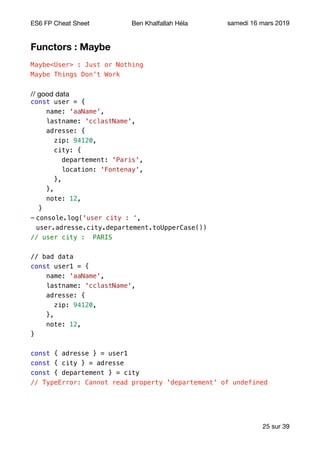
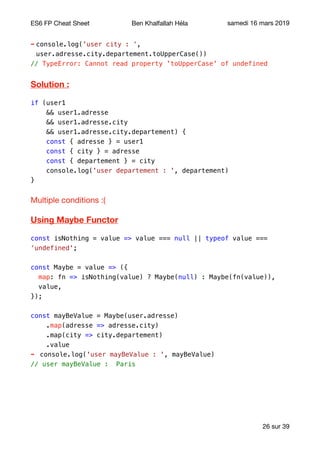

![ES6 FP Cheat Sheet Ben Khalfallah Héla samedi 16 mars 2019
Identity
The identity function (v => v) returns the exact same functor :
const NumberBox = number => ({
map: fn => {
if (typeof number !== 'number') {
return NumberBox(NaN);
}
return NumberBox(fn(number))
},
value: number,
});
const numberValue = NumberBox(5)
.map(v => v * 2) // 10
.map(v => v + 1) // 10 + 1
.value;
➡ console.log('numberValue : ', numberValue)// 11
const numberIdentity = NumberBox(5).map(v => v).value
➡ console.log('numberIdentity : ', numberIdentity)// 5
➡ console.log('NumberBox(5) : ', NumberBox(5).value)// 5
functor.map(x => x) ≡ functor
console.log([ 0, 1, 2, 3 ].map(x => x))
// => [ 0, 1, 2, 3 ]
sur28 39](https://image.slidesharecdn.com/fp-es6-cheat-sheet-190316121839/85/FP-Using-ES6-Cheat-Sheet-28-320.jpg)


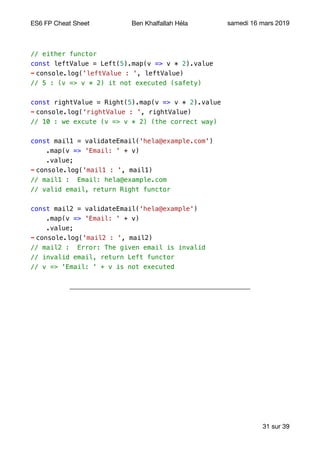

![ES6 FP Cheat Sheet Ben Khalfallah Héla samedi 16 mars 2019
const tryCatch = fn => value => {
try {
return Right(fn(value)); // everything went fine we go right
} catch (error) {
return Left(error); // oops there was an error let's go left.
}
};
const validateEmail2 = tryCatch(value => {
if (!value.match(/S+@S+.S+/)) {
throw new Error('The given email is invalid');
}
return value;
});
const get = key => value => value[key];
const emailVal1 = validateEmail2('hela@example.com')
.map(v => 'Email: ' + v)
.catch(get('message'))
.value;
➡ console.log('emailVal1 : ', emailVal1)
// emailVal1 : Email: hela@example.com
const emailVal2 = validateEmail2('hela@example')
.map(v => 'Email: ' + v)
.catch(get('message'))
.value;
➡ console.log('emailVal2 : ', emailVal2)
// emailVal2 : The given email is invalid
sur33 39](https://image.slidesharecdn.com/fp-es6-cheat-sheet-190316121839/85/FP-Using-ES6-Cheat-Sheet-33-320.jpg)


![ES6 FP Cheat Sheet Ben Khalfallah Héla samedi 16 mars 2019
Map, Flatten and Chain
const Maybe = value => ({
map: fn => isNothing(value) ? Maybe(null) : Maybe(fn(value)),
getOrElse: defaultValue => isNothing(value) ? defaultValue : value,
// we could return the value, but then we would sometimes switch
functor type.
// This way Maybe.flatten will always return a Maybe
flatten: () => isNothing(value) ? Maybe(null) : Maybe(value.value),
value,
});
const validateFlattenUser = user => Maybe(user)
.map(get('email'))
.map(v => validateEmail2(v).catch(get('message')))
.flatten()
// since now I will always have a simple Maybe,
// I can use getOrElse to get the value
.getOrElse('The user has no mail’);
const validFlattenUser = validateFlattenUser({
firstName: 'Hela',
email: 'hela@example.com',
});
console.log('validFlattenUser : ', validFlattenUser)
// validFlattenUser : hela@example.com
map(v => validateEmail2(v).catch(get(‘message')))
=> { map: [Function: map],
catch: [Function: _catch],
value: 'hela@example.com' } }
.flatten()
=> value.value => hela@example.com
sur36 39](https://image.slidesharecdn.com/fp-es6-cheat-sheet-190316121839/85/FP-Using-ES6-Cheat-Sheet-36-320.jpg)

![ES6 FP Cheat Sheet Ben Khalfallah Héla samedi 16 mars 2019
const inValidChainUser = validateChainUser({
firstName: 'Hela',
email: 'hela@example',
});
➡ console.log('inValidChainUser : ', inValidChainUser)
// inValidChainUser : The given email is invalid
const inValidChainUser1 = validateChainUser({
firstName: 'Hela',
});
➡ console.log('inValidChainUser1 : ', inValidChainUser1)
// inValidChainUser1 : The user has no mail
Functor : rules
Identity :
functor.map(x => x) ≡ functor
console.log([ 0, 1, 2, 3 ].map(x => x))
// => [ 0, 1, 2, 3 ]
Composition :
functor.map(x => f(g(x))) ≡ functor.map(g).map(f)
const fullNameOfPerson = (person) => (
person.firstName + ' ' + person.lastName
)
const greetingForName = (name) => `Hello, ${name}!`
We want to do greetingForName(fullNameOfPerson(person)) :
map(person => fullNameOfPerson(person))
map(person => greetingForName(person)) => apply greetingForName to the
first result
sur38 39](https://image.slidesharecdn.com/fp-es6-cheat-sheet-190316121839/85/FP-Using-ES6-Cheat-Sheet-38-320.jpg)
